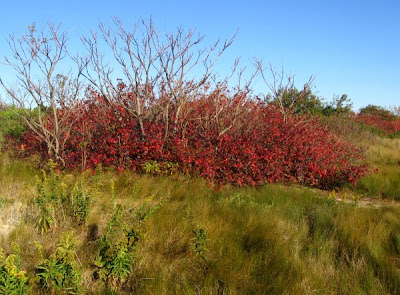Like yesterday at the grasslands, sparrows provided the birding highlights for today's trip to Sandy Hook. Song sparrows predominated; they were joined by several flocks of white-throated sparrows. The sparrow mix included a few field and swamp sparrows, along with single chipping and savannah sparrows. There has been some discussion among local birders about the abundance of white-crowned sparrows in the Mid-Atlantic this fall. I had not personally seen much evidence of that until today. There were small groups of white-crowned sparrows scattered all around the Hook, maybe a dozen total.
The real highlight, though, was a lifer - a Nelson's sharp-tailed sparrow at Plum Island. Unfortunately, the bird was backlit as it perched near the top of a reed, so we did not get the full effect of its bright buffy plumage. Still, it sat long enough for us to get a good look and identify it, not always a given with Ammodramus sparrows. It perched near a much-darker seaside sparrow, allowing comparison between the two closely-related species.
A few butterflies were still flying at Sandy Hook today. Highlights were a red admiral at Plum Island and a few common buckeyes on the edge of K-lot. Monarchs were all over, though not as abundant as a few weeks ago. Several sulphurs - both clouded and orange - rounded out my observations.
The diminishing number of butterflies signifies that autumn migrations are winding down. Hawks are still on the move, and it will be a month of more before waterfowl reach their usual winter numbers. Even many songbirds have yet to reach their winter homes. But the signs of fall migration's end are becoming unmistakable. Probably the most abundant species at Sandy Hook today was the yellow-rumped warbler, with few other warbler species to be seen. Hermit thrushes are appearing with increasing frequency, and songbird flocks have strong representation from ruby-crowned and golden-crowned kinglets and brown creepers. Songs of white-throated sparrows rise weakly from the underbrush. Brant, too, have taken possession of the coves they will occupy until April. While I enjoy all of these birds greatly, it is always sad knowing that their arrival means the end of hunting for migrant songbirds for another six months.
BIRD SPECIES: 52
Common Loon
Pied-billed Grebe
Double-crested Cormorant
Great Blue Heron
Great Egret
Snowy Egret
Canada Goose
Brant
American Black Duck
Sharp-shinned Hawk
Cooper's Hawk
Peregrine Falcon
Killdeer
Greater Yellowlegs
Ring-billed Gull
Great Black-backed Gull
American Herring Gull
Laughing Gull
Royal Tern
Mourning Dove
Downy Woodpecker
Eastern Phoebe
Golden-crowned Kinglet
Ruby-crowned Kinglet
Carolina Wren
Gray Catbird
Northern Mockingbird
Hermit Thrush
Black-capped Chickadee
Red-breasted Nuthatch
White-breasted Nuthatch
Brown Creeper
American Crow
Fish Crow
European Starling
Yellow-rumped Warbler
Palm Warbler
Common Yellowthroat
Eastern Towhee
Chipping Sparrow
Field Sparrow
Savannah Sparrow
Seaside Sparrow
Nelson's Sharp-tailed Sparrow
Song Sparrow
Swamp Sparrow
White-crowned Sparrow
White-throated Sparrow
Red-winged Blackbird
House Finch
American Goldfinch
House Sparrow





